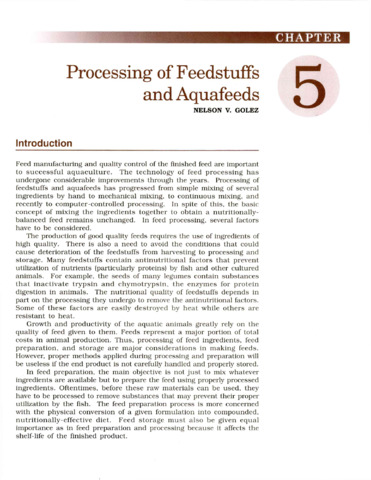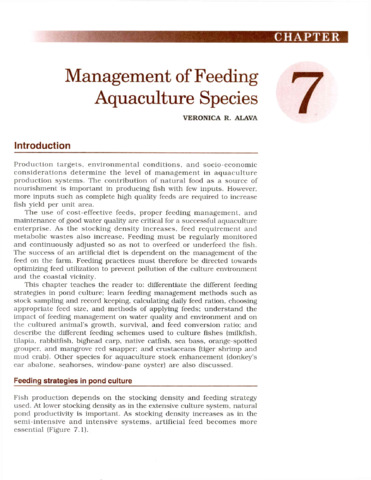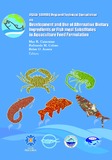| dc.contributor.author | Manaf, Mohammed Suhaimee Abd. | |
| dc.contributor.author | Omar, Ahmad Faizal Mohamed | |
| dc.contributor.editor | Catacutan, Mae R. | |
| dc.contributor.editor | Coloso, Relicardo M. | |
| dc.contributor.editor | Acosta, Belen O. | |
| dc.date.accessioned | 2016-08-08T09:46:02Z | |
| dc.date.available | 2016-08-08T09:46:02Z | |
| dc.date.issued | 2015 | |
| dc.identifier.citation | Manaf, M. S. A., & Omar, A. F. M. (2015). Status and development and use of alternative dietary ingredients in aquaculture feed formulation in Malaysia. In M. R. Catacutan, R. M. Coloso, & B. O. Acosta (Eds.), Development and Use of Alternative Dietary Ingredients or Fish Meal Substitutes in Aquaculture Feed Formulation : Proceedings of the ASEAN Regional Technical Consultation on Development and Use of Alternative Dietary Ingredients or Fish Meal Substitutes in Aquaculture Feed Formulation, 9-11 December 2014, Nay Pyi Taw, Myanmar (pp. 15-21). Tigbauan, Iloilo, Philippines: Aquaculture Department, Southeast Asian Fisheries Development Center. | en |
| dc.identifier.isbn | 9789719931058 | |
| dc.identifier.uri | http://hdl.handle.net/10862/2986 | |
| dc.description.abstract | In 2013, capture fisheries contributed 85% (1.48 million mt) of total fish production in Malaysia. An additional 17.6% (261,000 mt) was recorded as fish-by-catch (FBC). On the contrary, aquaculture contributed 15% (260,800 mt) of the total fish production (49.0% marine fish and 51.0% freshwater fish). An estimated 150,000 mt FBCs were processed to fish meal (FM) producing 30,000 mt FM annually. In 2013, 16,600 mt of FM, valued at MYR50 million (USD15.6 million) were exported while 7,700 mt valued at MYR33 million (USD10.3 million) were imported. FBCs may consist of fish, crustaceans, mollusks and others. The quality of each FBC sample differs depending on the amount of fish and varies with the season and fishing ground. The use of FM, plant protein sources and fish oil (FO) in the aquafeed industry is not known. However, based on marine fish and shrimp feed price, the use of FM and FO in aquafeed was estimated to be 30-40%. Studies on FM and FO replacement in aquafeed using poultry by-product meal, fermented shrimp head waste, soybean meal, palm oil and soybean oil as well as the use of biofloc technology in white shrimp farming were also discussed. In order to improve feed and feeding practices, Department of Fisheries, Malaysia conducted good aquaculture practices on feeding management, feed formulation and fish nutrition courses to stakeholders (farmers and government officials). In addition, there are measures taken to monitor feed and feeding practices through random auditing process in aquaculture farms in Malaysia based on Good Aquaculture Practices (MyGAP) and Animal Feed Act 2009. Due to the increasing price of FM and FO, the aquafeed industry has started to replace in the feed formulations since the increasing feed cost has hindered farmers from buying aquafeed. As a result, there were traces of porcine DNA detected in almost all commercial aquafeed. Additionally, aquaculture farmers tend to formulate their own farm-made aquafeed instead of using commercial pellets. Thus, in order to sustain fish production, Department Fisheries promotes farming and consumption of omnivorous and herbivorous fish species as tilapia, catfish and grass carp. In addition, the Department of Fisheries also organizes Aquaculture Practices Awareness programs among aquafeed manufacturers and farmers to implement relevant rules and act to reduce the use of FM and FO. Lastly, research and development on FM and FO substitution in aquafeed with locally available ingredients are still ongoing and being done by Department of Fisheries, universities and the private sector. | en |
| dc.language.iso | en | en |
| dc.publisher | Aquaculture Department, Southeast Asian Fisheries Development Center | en |
| dc.subject | Malaysia | en |
| dc.title | Status and development and use of alternative dietary ingredients in aquaculture feed formulation in Malaysia | en |
| dc.type | Conference paper | en |
| dc.citation.spage | 15 | |
| dc.citation.epage | 21 | |
| dc.citation.conferenceTitle | Development and Use of Alternative Dietary Ingredients or Fish Meal Substitutes in Aquaculture Feed Formulation : Proceedings of the ASEAN Regional Technical Consultation on Development and Use of Alternative Dietary Ingredients or Fish Meal Substitutes in Aquaculture Feed Formulation, 9-11 December 2014, Nay Pyi Taw, Myanmar | en |
| dc.subject.asfa | animal nutrition | en |
| dc.subject.asfa | feeding | en |
| dc.subject.asfa | fishmeal | en |
| dc.subject.asfa | feeds | en |
| dc.subject.asfa | aquaculture development | en |
| dc.subject.asfa | aquaculture | en |
| dc.subject.asfa | sustainability | en |
| dc.subject.asfa | fish culture | en |
| dc.subject.asfa | biotechnology | en |
| dc.subject.asfa | feed composition | en |



